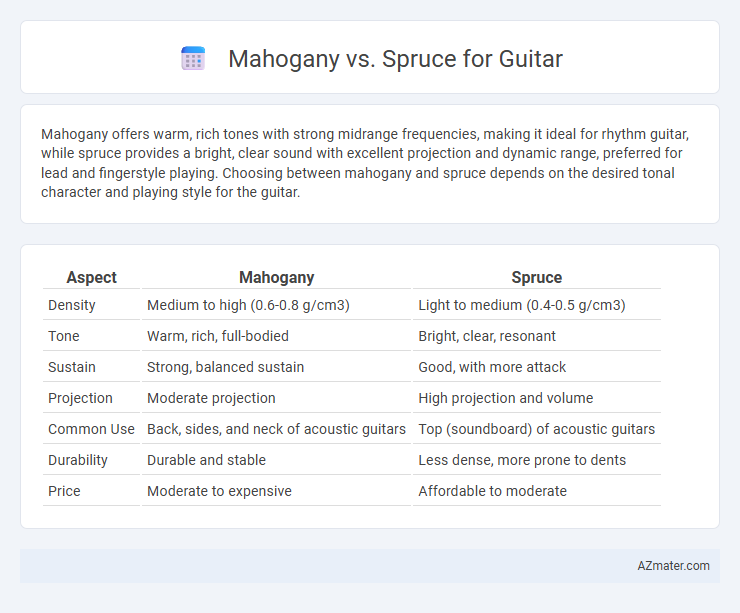Mahogany offers warm, rich tones with strong midrange frequencies, making it ideal for rhythm guitar, while spruce provides a bright, clear sound with excellent projection and dynamic range, preferred for lead and fingerstyle playing. Choosing between mahogany and spruce depends on the desired tonal character and playing style for the guitar.
Table of Comparison
| Aspect | Mahogany | Spruce |
|---|---|---|
| Density | Medium to high (0.6-0.8 g/cm3) | Light to medium (0.4-0.5 g/cm3) |
| Tone | Warm, rich, full-bodied | Bright, clear, resonant |
| Sustain | Strong, balanced sustain | Good, with more attack |
| Projection | Moderate projection | High projection and volume |
| Common Use | Back, sides, and neck of acoustic guitars | Top (soundboard) of acoustic guitars |
| Durability | Durable and stable | Less dense, more prone to dents |
| Price | Moderate to expensive | Affordable to moderate |
Introduction to Mahogany vs Spruce in Guitar Making
Mahogany and spruce are two of the most popular tonewoods used in guitar making, each offering distinct tonal characteristics. Mahogany provides a warm, rich sound with pronounced midrange frequencies, ideal for blues and folk styles. Spruce, on the other hand, delivers a bright, clear tone with strong projection and dynamic range, making it a preferred choice for various playing techniques and genres.
Overview of Mahogany and Spruce Wood Properties
Mahogany wood is known for its dense, warm, and resonant tonal qualities, offering strong midrange frequencies and a solid sustain, making it ideal for rhythm and blues styles. Spruce, particularly Sitka spruce, is prized for its light weight, stiffness, and bright, clear sound with excellent dynamic range, enhancing attack and articulation in guitar tops. The contrast between mahogany's warmth and spruce's brightness provides distinct sonic characteristics that influence the overall tone and projection of acoustic guitars.
Tonal Characteristics: Mahogany vs Spruce
Mahogany offers a warm, rich tone with pronounced midrange frequencies and a smooth, balanced sound favored for blues and folk guitar styles. Spruce provides a bright, clear, and dynamic tone with strong projection and excellent articulation, making it ideal for versatile playing and genres like bluegrass and classical. The tonal characteristics of mahogany emphasize warmth and depth, while spruce highlights brightness and clarity across the guitar's frequency spectrum.
Durability and Longevity of Mahogany and Spruce Guitars
Mahogany guitars are renowned for their exceptional durability and resistance to wear due to the wood's dense, tight grain structure, making them ideal for long-term use. Spruce guitars, while slightly more susceptible to dents and scratches because of their softer, lighter wood, offer excellent longevity when properly maintained, with their strong, elastic fibers supporting sustained tonal quality. Both woods provide durable options but mahogany tends to withstand physical impacts better, whereas spruce requires careful handling to maximize its lifespan.
Visual Aesthetics: Comparing Mahogany and Spruce
Mahogany guitars exhibit a rich, warm brown color with a fine, straight grain that offers a classic and elegant appearance, often favored for its vintage charm. Spruce tops are light-colored with a tight, uniform grain pattern, emphasizing a clean, bright aesthetic that visually conveys clarity and resonance. The contrast between mahogany's darker hues and spruce's pale tone creates distinct visual appeals, influencing the overall instrument style and perceived tonal quality.
Weight and Playability Differences
Mahogany guitars are generally heavier due to the wood's density, offering a warmer tone and enhanced sustain, while spruce guitars are lighter, providing bright, clear sounds with greater resonance. The weight difference impacts playability, as players often find spruce models easier for extended sessions because of reduced fatigue. Spruce's stiffness and responsiveness suit fast fingerpicking, whereas mahogany's heft supports strong strumming and richer midrange frequencies.
Price Range and Availability
Mahogany guitars generally fall within a mid-range price bracket, offering balanced affordability and durability, making them widely available in both entry-level and professional models. Spruce tops are often found on guitars priced from mid to high ranges due to their superior tonal clarity and responsiveness, and premium spruce varieties can be more scarce and expensive depending on the grade. Availability of mahogany is relatively stable globally, while high-quality spruce, especially Sitka or Engelmann varieties, may experience more regional supply fluctuations, influencing overall cost.
Best Guitar Styles for Mahogany and Spruce
Mahogany guitars excel in delivering warm, rich tones with strong midrange presence, making them ideal for blues, folk, and fingerstyle playing. Spruce guitars offer bright, clear, and responsive sound with excellent projection, best suited for bluegrass, country, and flatpicking styles. Choosing between mahogany and spruce depends on the desired tonal character and playing technique, as mahogany enhances midrange warmth while spruce emphasizes brightness and clarity.
Maintenance and Care Considerations
Mahogany guitars require regular humidity control to prevent wood cracking and warping, as their dense grain absorbs moisture more slowly but is susceptible to dryness. Spruce tops need consistent moisture levels to avoid cracking, though they generally respond well to moderate changes and benefit from occasional conditioning with guitar-specific oils. Both tonewoods benefit from proper storage in guitar cases with humidity packs to maintain optimal tonal quality and structural integrity over time.
Choosing the Right Wood: Mahogany or Spruce for Your Playing Style
Mahogany offers a warm, mellow tone with strong midrange emphasis, ideal for blues, folk, and rhythm guitarists seeking depth and sustain. Spruce provides a bright, clear sound with excellent dynamic range and projection, preferred by fingerstyle players and lead guitarists needing articulation and attack. Choosing between mahogany and spruce depends on your playing style--mahogany suits softer, more expressive techniques, while spruce excels in versatile, intricate playing requiring clarity.

Infographic: Mahogany vs Spruce for Guitar
 azmater.com
azmater.com